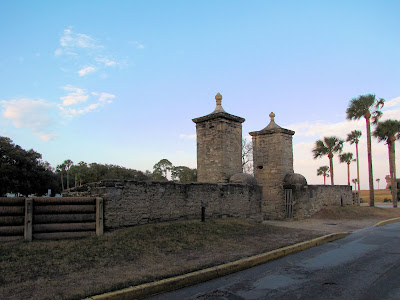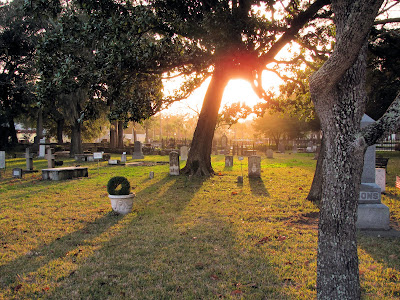
A few hours at the Alligator Farm in St. Augustine is worth the time. It included a couple of shows and a wide range of animals from the four corners, including South American caimans and macaws to Eastern Diamondback rattlesnakes and, of course, gators. Lots of them. Since the rain wa
s trying to play us up and I only had the one afternoon to explore the oldest continuously inhabited city in America it was time to move on to el Castillo de San Marcos, the Spanish fort built to guard the new colony and the immediate intra-coastal waterway.
I had never known of a Spanish fort anywhere in the continental United States. And it was big, complete with a dry moat, cannons, some with a range of up to three miles, wer

e mounted atop walls up to 60 feet thick at the base and a small museum in the rooms off of the central courtyard preserving artifacts and letters from the time. Each corner or "bastion" was diamond shaped to allow a withering crossfire against any enemy on land or out to sea. At the tip were these lonely sentry posts with peepholes through which any traffic of interest might be monitored.
In the days before radar, sat-com and AWAC there was simply no getting by this formidable redoubt which ironically guarded a settlement that even today barely tops 12,000 citizens. In the larger scheme of 16th and 17th century America, however, San Marcos anchored the Florida coastline for ships returning to Spain and maintaining a toehold on the continent for Spanish interests against English, French and Native American pressure.
Directly across the A1A coastal highway is the remains of the main north gate w

hich protected the inner part of the colony while the fort guarded the sea approaches. Nearby and notably outside the city gates is the Huguenot Cemetery which, while not associated specifically with French Huguenots, was dedicated in 1821 as the burial place for non-Catholic victims of age, war and plague in the area. The cemetery closed to new burials only a few decades after it first opened but thanks to haunted ghost stories from some of the interred it remains as compelling a part of the local history as any other site.
I skipped the Fountain of Youth as the brochures made it look as appealing as a

roadside carnival, loaded with kitsch and cotton candy but not much substance. Likewise the central part of the city was well preserved from the outside but inside was little more than a tourist mall of gift shops, high end clothiers and "local flavor" eateries, crass commercialism at its finest. The fort, however, silently said it all. It held vigil over a bygone era and truly brought home how hotly contested the New World had been.
Maybe to enhance the already impressive fort someone will find a way to anchor a Spanish galleon, a French frigate and a British ship-o'-the-line alongside to complete the picture.
Gotta go.
No comments:
Post a Comment